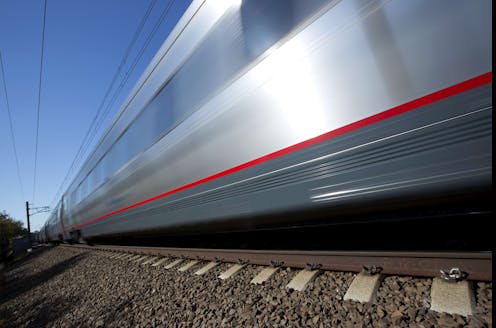How trains linked rival port cities along the US East Coast into a cultural and economic megalopolis
- Written by David Alff, Associate Professor of English, University at Buffalo

The Northeast corridor is America’s busiest rail line. Each day, its trains deliver 800,000 passengers[1] to Boston, New York, Philadelphia, Washington and points in between.
The Northeast corridor is also a name for the place those trains serve: the coastal plain stretching from Virginia to Massachusetts, where over 17% of the country’s population lives on less than 2% of its land[2]. Northeasterners ride the corridor and live there too.
Like “Rust Belt,” “Deep South,” “Silicon Valley” and “Appalachia,” “Corridor” has become shorthand for what many people think of as the Northeast’s defining features: its brisk pace of life, high median incomes and liberal politics. In 1961, Republican Sen. Barry Goldwater of Arizona wished someone had “sawed off the Eastern Seaboard[3] and let it float out to sea.” In 2016, conservative F.H. Buckley disparaged “lawyers, academics, trust-fund babies and high-tech workers, clustered in the Acela Corridor[4].”
As a scholar of language and literature[5], I’m interested in what words can teach us about places. My new book, “The Northeast Corridor[6],” shows how America’s most important rail line has shaped the Northeast’s cultural identity and national reputation for almost 200 years. In my view, this bond between transit and territory will only strengthen as new federal investments[7] in passenger service draw more Northeasterners aboard trains.
Forming a great chain
The first American railroads were stubs – strap iron curiosities that hauled marble, granite and coal in winter months when canals froze. It was not until 1830 that the Baltimore & Ohio Railroad opened the nation’s first public passenger line[10].
Railway mania ensued. Within a few years, trains were crisscrossing the Eastern Seaboard. A new periodical, The Railroad Journal[11], predicted that tracks would one day form a “great chain which, is in our day to stretch along the Atlantic coast, and bring its chief capitals into rapid, constant, and mutually beneficial relation.”
The Boston & Providence Railroad forged one link of this chain in New England. The Philadelphia & Trenton cast another in Pennsylvania, and the Philadelphia, Wilmington, & Baltimore hammered out a third through Delaware and Maryland. Named for the cities they linked, these carriers helped turn a collection of rival ports into a cohesive economic unit.
Despite their rapid growth, each railroad remained a separate fiefdom beset by its own state mandates, financial shortfalls and technological limitations. An antebellum train trip from Baltimore to New York would have required multiple transfers and two ferry rides, and taken most of a day.
The “great chain” began to take modern shape in the late 19th century as corporate consolidations created two highly resourced super carriers: the New Haven and Pennsylvania railroads. Engineering advances permitted the construction of new bridges, embankments and terminals. With the opening of a tunnel under the Hudson River[12] from New Jersey to Manhattan in New York City in 1910, and a bridge over Hell Gate Strait[13] between the New York boroughs of Queens and the Bronx in 1917, trains could roll continuously between New England and the Chesapeake region.
Connecting a megalopolis
Railroading became a way of life for Northeasterners. Physicist Albert Einstein liked watching trains click-clack through Princeton Junction during his time at the Institute for Advanced Study in Princeton, New Jersey in the 1930s and 1940s.
Composer George Gershwin, who rode by rail from New York to Boston, claimed that “it was on the train with its steely rhythms, its rattlety bang” that “I suddenly heard – and even saw on paper – the complete construction of ‘Rhapsody [in Blue]’ from beginning to end.”
Their fellow passengers included luminaries like poet Marianne Moore[15], jazz composer and pianist Duke Ellington[16] and orchestra conductor Leopold Stokowski[17], along with countless ordinary riders whose lives sprawled across the region.
In 1961, French-Ukrainian geographer Jean Gottmann[18] called the Northeast a “new order in the organization of inhabited space[19].” Gottmann observed that unlike European nations, which developed around dominant capitals like London and Rome, the United States grew from a “polynuclear” fusion of cities and suburbs that he called “Megalopolis.”
The relative proximity of megapolitan cities generated a “tidal current of commuting” between them, which Gottman experienced firsthand while riding trains between academic appointments in Baltimore, Princeton and Manhattan.
One of Gottman’s adherents, Rhode Island Sen. Claiborne Pell, imagined the Northeast in 1962 as “one long metropolitan industrial unit[20].” A frequent rider, Pell believed that trains played an essential role in the region’s interlocking economy.
Amtrak takes over
As railroads lost riders to cars, buses and jets in the 1960s, Pell urged President John F. Kennedy to create a government agency that would operate passenger trains for the public good. He called the tracks between Boston and Washington a “passageway for gargantuan surges of movement along our Northeast seaboard[22]” – or, a “corridor” for short.
The name stuck. When Amtrak took over U.S. intercity passenger rail travel[23] in 1971, the Northeast corridor hosted its most popular trains – including the stylish, if breakdown-prone Metroliners[24], which whisked business-class passengers between New York and Washington at velocities topping 100 mph.
By 1978, the Northeast accounted for over half of Amtrak’s ridership. The region’s rail revival convinced Congress to spend US$1.75 billion[25] in the 1980s on the Northeast Corridor Improvement Project, a multi-year effort to modernize the line, renovate stations and trim schedules.
In 2000, Amtrak debuted the Acela Express, a sleek and pricey train that was billed as the first U.S. high-speed passenger rail service[26]. Acela grew synonymous with its well-heeled clients, but seldom reached its top speed of 150 mph on the corridor’s curving and congested tracks[27].
The train still became a symbol for Northeasterness. Pundits took to calling the presidential nominating contests held on the same day in Rhode Island, Connecticut, Pennsylvania, Delaware and Maryland the “Acela Primary[28].” Conservatives railed against “Acela Corridor” ways of thought[29].
The $16 billion Gateway Hudson Tunnel Project will build a new rail tunnel under the Hudson River from New Jersey to New York and renovate the existing 100-year-old tunnel.Today, President Joe Biden – a longtime corridor commuter – is proposing to kick off a “second great rail revolution[30],” with billions of dollars in funding[31] to strengthen and expand Amtrak’s network.
High-speed rail projects in California[32], Nevada[33] and Texas[34], meanwhile, promise to bring world-class service to the West and South. Construction has begun on Brightline West, a high-speed link from Las Vegas to Los Angeles[35]. What these ventures will make of their regions remains unseen. But if the Northeast corridor is any indication, new passenger trains will redefine both the working lives and cultural perceptions of those who use them.
This article has been updated to reflect that the Institute for Advanced Study in Princeton, New Jersey is not affiliated with Princeton University.
References
- ^ deliver 800,000 passengers (www.transportation.gov)
- ^ lives on less than 2% of its land (www.google.com)
- ^ sawed off the Eastern Seaboard (www.usatoday.com)
- ^ clustered in the Acela Corridor (books.google.com)
- ^ scholar of language and literature (scholar.google.com)
- ^ The Northeast Corridor (press.uchicago.edu)
- ^ new federal investments (www.cnn.com)
- ^ Northeast Corridor Infrastructure and Operations Advisory Committee (nec-commission.com)
- ^ CC BY-ND (creativecommons.org)
- ^ the nation’s first public passenger line (www.loc.gov)
- ^ The Railroad Journal (onlinebooks.library.upenn.edu)
- ^ tunnel under the Hudson River (en.wikipedia.org)
- ^ bridge over Hell Gate Strait (untappedcities.com)
- ^ Library of Congress (loc.getarchive.net)
- ^ poet Marianne Moore (www.poetryfoundation.org)
- ^ jazz composer and pianist Duke Ellington (www.britannica.com)
- ^ orchestra conductor Leopold Stokowski (www.britannica.com)
- ^ French-Ukrainian geographer Jean Gottmann (www.britannica.com)
- ^ new order in the organization of inhabited space (www.nytimes.com)
- ^ one long metropolitan industrial unit (www.nytimes.com)
- ^ AP Photo/Gerald Herbert (newsroom.ap.org)
- ^ gargantuan surges of movement along our Northeast seaboard (www.google.com)
- ^ took over U.S. intercity passenger rail travel (history.amtrak.com)
- ^ the stylish, if breakdown-prone Metroliners (passengertrainjournal.com)
- ^ US$1.75 billion (railroads.dot.gov)
- ^ first U.S. high-speed passenger rail service (railroads.dot.gov)
- ^ curving and congested tracks (www.cnn.com)
- ^ Acela Primary (www.theguardian.com)
- ^ Acela Corridor” ways of thought (robertkelchen.com)
- ^ second great rail revolution (www.progressiverailroading.com)
- ^ billions of dollars in funding (www.whitehouse.gov)
- ^ California (hsr.ca.gov)
- ^ Nevada (www.brightlinewest.com)
- ^ Texas (www.texascentral.com)
- ^ high-speed link from Las Vegas to Los Angeles (apnews.com)
Authors: David Alff, Associate Professor of English, University at Buffalo



